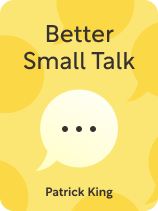

This article is an excerpt from the Shortform book guide to "Better Small Talk" by Patrick King. Shortform has the world's best summaries and analyses of books you should be reading.
Like this article? Sign up for a free trial here.
Are you prepared to start meaningful conversations and keep them going? Do you have a conversation résumé? If you were to have one, what would go on it?
To get better at any sort of conversation, you need to prepare to have it beforehand—in the same way you should warm up your muscles before running a race. Social interaction specialist Patrick King shares five conversation preparation techniques to set you up for greater success in conversations.
Keep reading to learn how to always be prepared for quality conversations.
#1: Develop a Conversation Résumé
A conversation résumé is a mental list of the things about you that are interesting and would engage other people. Having a conversation résumé ensures you enter any conversation with a few good talking points and avoid awkward pauses. According to King, you should craft and regularly update four parts of your conversation résumé so you can easily talk about them in any context: 1) what’s going on in your day or week, 2) what’s going on in your life more broadly, 3) unique experiences and traits you have, and 4) your takes on current events.
(Shortform note: “Conversation résumé” is a good term for this mental summary of your life highlights. Like a real résumé, the conversation résumé only features the best experiences you’ve gathered. You thus avoid talking about negative or insignificant topics with either a hirer or a new acquaintance. And both conventional and conversation résumés make it easier to summon these key experiences to mind. Still, there’s one key difference between a job résumé and a conversation résumé: The former is a marketing tool while the latter is a resource that lets you connect meaningfully with others. King warns in the book that viewing a conversation as a way to promote yourself will likely push people away—the opposite effect you want to have.)
Exercise: Create Your Own Conversation Résumé
King recommends creating a mental resume of your most interesting life experiences that you can draw on in any conversation. In this exercise, think about what might go on your conversation résumé and how you can speak about those experiences engagingly.
- Reflect on what’s been going on in your week. Has anything interesting happened at work or on the weekend? Write a three-sentence mini-story to describe this experience.
- Think more broadly about the last few months of your life. Are there any ongoing experiences that might be interesting to share? (For example, you or your partner might be pregnant or you might be training for a race). Write a mini-story about this experience.
- Zoom out even further, and think about your entire life. Do you have any unique or extraordinary life experiences to talk about? Can you transform them into a mini-story?
- Finally, reflect on what’s happening in the news. Do you have any opinions or insights into current events? Write a mini-story that covers a current event and your take on it.
#2: Have More Low-Pressure Interactions
When you engage frequently in short, unimportant conversations, you keep your social and conversation muscles warmed up. These interactions can be brief: Simply asking a question or making an observation to another person is sufficient. King suggests, for example, that you make use of mundane interactions with service workers to warm up. It’s part of their job to make you, as a customer, feel good, so there’s little danger of it going awry. Plus, they’re often bored at work and appreciate some light engagement.
(Shortform note: Preparing to have conversations might be even more important in the wake of the Covid-19 pandemic. During the pandemic, when most social interactions took place on screens, many people felt they simply forgot how to have in-person conversations—in other words, their social muscles atrophied. However, at the same time, people increasingly began taking out their frustrations on service workers, possibly because doing this helped them feel less powerless during an unpredictable time. All this makes it perhaps more important to hone your social skills in low-pressure interactions with service workers and be especially kind to them.)
#3: Prepare Your Voice for Conversation
To sound confident and charismatic in conversation, you need to also warm your voice up. You can do this by reading something out loud—ideally something with emotional weight (like a paragraph from a work of fiction or a play). Once you’ve read it, read it again with as much exaggerated emotion as possible—if there’s a sad part, read it with extreme pathos, for instance. While doing this, try to speak clearly and at a comprehensible pace. Project your voice and avoid a monotonous tone.
(Shortform note: Behavioral expert Thomas Erikson might argue that this type of vocal warm-up doesn’t serve everyone. In Surrounded by Idiots, he writes that people have different personality types and, as such, have different communication styles. Only some personality types are highly expressive in the way King intends his warm-up to make you. Other personality types speak in a more subdued manner, with few tonal shifts and little inflection. Erikson might assert that you shouldn’t try to change your communication style to be more expressive but rather find the vocal warm-up that prepares you to best express yourself in your natural communication style.)
#4: Expand Your Field of Reference
King writes that people generally prefer to talk to others who lead interesting lives and can contribute thoughts on a wide range of topics. He says you can prepare to have more engaged conversations by expanding your field of reference: Pursue more of your interests and educate yourself about new topics and ideas.
(Shortform note: King’s advice to expand your field of reference helps you achieve goals other than higher-quality conversations. In Talk Like TED, Carmine Gallo writes that regularly learning and doing new things gives you more material to work with when giving speeches and presentations, thereby making them more interesting and engaging. David J. Schwartz also notes in The Magic of Thinking Big that when you explore new ideas, you can think with greater creativity, which in turn makes you more likely to find success in work and life. So no matter what you do, there’s likely some benefit to expanding your field of reference.)
#5: Become More Open-Minded
If you constantly judge or shut down others’ views, people won’t feel comfortable when talking to you and will eventually avoid you entirely. Prepare to have good talks by becoming more open-minded and tolerant of new opinions. To do this, King encourages you to avoid making assumptions, stop clinging to your own views and opinions, and prioritize connection over being right.
(Shortform note: King includes this point at the end of the book, but his recommendations for how to become more open-minded are meant to take place during the conversation. In other words, for example, in conversation, you’d stop yourself from making assumptions about what the other person is saying. Because it’s important to enter a conversation with these ideas in mind, we’ve moved this idea to the section on preparing for conversations. This better reflects the reality that becoming open-minded requires real mental preparation.)

———End of Preview———
Like what you just read? Read the rest of the world's best book summary and analysis of Patrick King's "Better Small Talk" at Shortform.
Here's what you'll find in our full Better Small Talk summary:
- Why small talk is a critical part of any conversation
- How mastering small talk can help you have more meaningful conversations
- How to become a better conversationalist, storyteller, and listener






